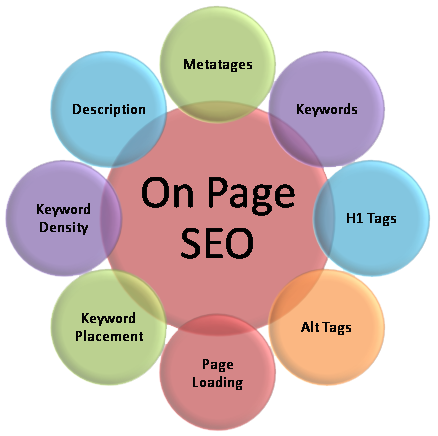Hello!
In this post i'm going to explain what is SEO On page optimization and what are the factors we should implement for improving our website visibility in search engines to get higher rankings in SERP as well as good traffic for website as per my experience.
In the previous post
What is SEO, i gave quick introduction for SEO On page optimization but in this post i will cover in-depth. Google and all other search engines go through lot of factors ( around 200) to refine the websites that contain user searched keywords in their content to satisfy the website visitors experience in providing good informational content by displaying useful informative sites in search engine page results. So every aspect of optimization is very important for an SEO executive to improve a website to place it in top organic search engine results.

SEO On page optimization defined as optimizing activities performed within a website to improve website visibility and get higher rankings. Lets see the SEO on page optimization factors one by one
1. URL Canonicalization: In general terminology we can say it as WWW resolve. Canonical URL concept is related to the selection of best URL for a website that visitors want to see. Lets understand by an example
- www.domain-name.com/index.html
In user or website visitors point of all URLs are same and they take us to same web page but in search engines view all those URLs are different and this can be considered as duplicate webpages contained same content.
So to overcome this duplication problem, we need to insert a attribute "canonical" to prioritize our best URL for the site. Write following HTML tag to overcome this issue
<link href="www.domain-name.com" rel="canonical">
2. IP Canonicalization: Every web address contains a IP. whenever you type a domain in address bar that goes to specific IP address and display the content available at that particular IP.
Lets come to our IP canonicalization: We should check our website is displaying or not by entering our IP address in the web browser.
3. HTTPS (SSL): Hyper Text Transfer Protocol Security (Secured Socket Layer). Websites with SSL will more secured through money transaction happen like E-commerce sites, doesn't require for common informative sites but having it is important.
4. Domain Age: Domain age means how long a website has been exist, if you are running your website for years: search engines prefers long running sites to show up in results.
you can check domain age of website using www.whois.net
5. Technology Lookup: Checking a website is developed using which programming language. Knowing this will be advantage for executive to easily optimize.
you check technology with: www,builtwith.com
6. Favicon: Short icon, Tab icon, URL icon of a webpage. preferred favicon size is 16*16 pixels.
7. Page Title: This is the most important factor focus on in on page activity because it is the first thing displays in SERP. We should create it as per web page content and major focused keyword to rank our website. The charcter limit for page title is 70 characters.
8. Meta Description: It is also important along with page title that displays in SERP. It is the brief summary of a webpage content, limited to 160 characters. use main keyword in meta description.
9. Meta Keywords: Foremost important factor rank a webpage in SERP. limit meta keywords to mainly 5 keywords for a single page. character limit is 200 to 250 characters.
10. Image alternate text: Search engines can not read or process images so we need to mention an alternative text for the images to crawl and index them.
Syntax: <img src="img.jpg" alt="image name" />
11. Header Tags: h1, h2, h3, h4, h5, h6 are the header tags. We don't use all these but we must use first three tags in every webpage. limits are h1 (1), h2 (2 or 3), h3 (no limit).
12. URL Optimization: URL also main factor that showcase in SERP results with title and description. optimizing a web page address with text or words separated with hyphen symbols so can a user easily understand the content available in that website while displayed in SERP.
13. HTML sitemap: It is a collection all web pages of a site in a HTML page format so a user can easily navigate through all the web pages. Make sure that your website has a HTML sitemap.
you can check it with following syntax: www.your-domain-name.com/sitemap,html
14. XML Sitemap: XML sitemap is for search engine purpose, it provides an easy way for search engines to crawl and index them. It updates robots about frequently changed in a website.
you can check it with following syntax: www.your-domain-name.com/sitemap,xml
15. Robots file: it is a file helpful instruct robots to crawl or not to crawl a particular page on your site. By default search engines crawl all of your webpages.
Syntax: User-agent: *
Disallow: / Home page /
Allow: / Home page /
16. Custom 404 Errors: Whenever a webpage does not exist or renamed then search engine displays 404 errors. You should redirect 404 error pages to new URL.
17. Device and Browser compatibility: Our website should be dynamic and should compatible for all the types of devices. Mainly your website should be mobile friendly as per current generation. You can check your website compatibility with Google Mobile Friendly Tool.
18. Site Speed: Your website load time should be very minimum, minimize all the rich media files, and JavaScript codes.
19. Google Analytics Code: Check your website is connected with google analytics or not to check clear website traffic and other details.
20. Google Search Console Validation: Check your website is connected with google search console or not to check your webpage index status, crawl errors, keyword performances.


Comments
Post a Comment